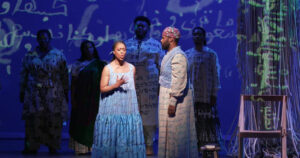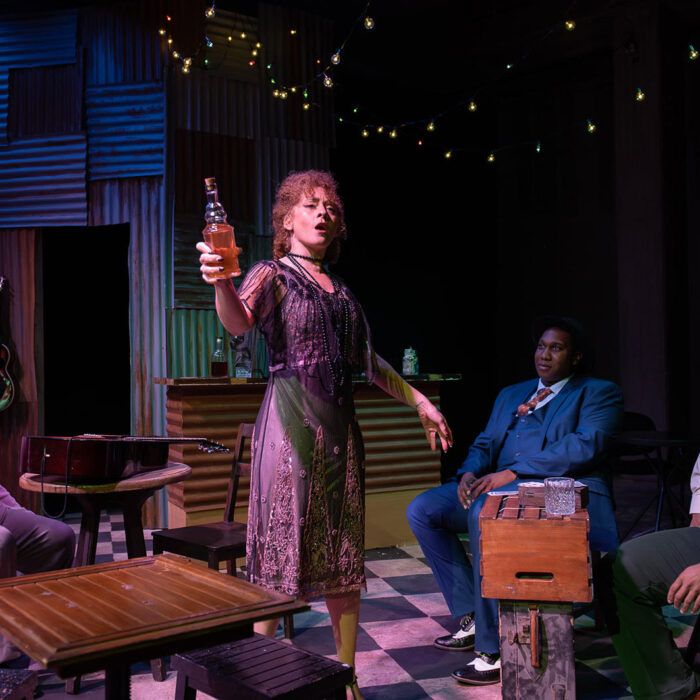
San Francisco Opera 2023-24 Review: Omar
Omar ibn Said’s Reckoning and Reconciliation Between the Forces of Darkness and Light
By Lois SilversteinOmar is a man, forcibly taken from his home in West Africa in 1807, and brought through the Middle Passage to America. He is sold into slavery in South Carolina and treated with brutality. He maintains his Muslim faith and eventually while in captivity, writes his autobiography in Arabic.
“Omar” is an opera created by MacArthur Fellowship recipient Rhiannon Giddens, and Pulitzer Prize winning and Emmy and Grammy-nominated composer Michael Abels. It opened at San Francisco Opera under the baton of John Kennedy. Kennedy led the world premiere at the Spoleto Festival USA in 2022.
The San Francisco Opera Orchestra performed the lavish production by Kaneza Schaal, full of vision and a compelling story. The lynchpin of the work is Omar ibn Said’s autobiography, which the production highlights in Set and Production design by Christopher Myers and Amy Rubin and Choreographer Kiara Benn. Omar’s autobiography is highlighted throughout the production by the Arabic letters on almost every costume, set decoration, scrim, and usable object. The message? Here’s a human being whose story we must never forget.
The Story as a Production
In addition to the luxurious production, an abundant array of scenes with large and centralizing objects, including buildings and a large tree with multiple roots dominated the telling. It was a startling choice for a story that aimed at conveying the intense and painful story of one man in his imprisonment. Yet, the display lifted the individual story into the larger societal world. A world in which enslavement of different kinds prevail. But instead of confinement, we see a vision of expansion; instead of fright and horror, we see possibilities of freedom and fulfillment.
However, the abundant production seemed to be a case of too many and too much. For instance, the big tree was excellent, but the stressing of all the activity at its base and its roots seemed too dominant. In addition to which, it seemed at one moment like an imminent Maypole dance was about to ensue, with intertwining strands. Also, the overall production experience remained in nearly constant motion, scrims rising and descending with text already on them or being written while other action was going on. Flats moving on and off stage, changing size or becoming vehicles for additional projections, or featuring in another configuration yet another perspective. Original yes, on the one hand, rich with ideas; on the other, a dilution of focus and intensity.
Another example was the jail scene in the first Act. Instead of a more conventional portrayal, there were suspended ropes for bars and abundant flowing fabrics for walls. Was this in fact a jail? Yes. It broke the mold by being luxurious instead of stark and murderous, and this was stimulating. It pointed to another perspective, but it also weakened the immediacy of the suffering. The slave block in the other hand, was clichéd and did not raise another perspective. In addition it showed too many examples and went on too long, with only bits of other lives and their tragedies. Did we need all?
The lighting, designed by Pablo Santiago, particularly in the second act was very effective as the extraordinary tree shifted from amber to golden, blue, to white. But then, did it need the ramps? Not really. Did it need the characters running through the audience, beyond the surprise factor? No. The last three shows at San Francisco Opera had characters in the aisles. Too much of a good thing, and questionable relevance, came to mind. Not for the sake of it. It was interesting to have the dressing of Omar on stage and the undressing. The thread of it was here now. It was a story and more than the story. While very important, the creators kept reminding us that this was a live issue for us and we must be engaged and move to action as a result of it. Sometimes, however, foreground and background needed more articulation, more distinction. In fact, the whole production kept reminding us of itself, from the scrims, the projections, the costume and set shifts, and the tactics of the feeling of endless movement.
This caused the drama to become more subdued than it might have been, for instance between the characters: mother and son, Omar and Julie, Omar by himself, talking, praying, invoking the god he devoted himself to. Also, the libretto itself could have used more editing. Repetition of idea and fragments of thought could have been reduced for dramatic emphasis. Dialogues were more talky than needed. Also, some of the pedagogical information could have been dramatized more, rather than repeated. In Act one, the repetition of structure of conversation as a narrative method dampened the drama. Comparison of Psalm 23, from the King James Version, with the Muslim text of Omar’s prayer remained very interesting, timely and relevant. To lay both out was very timely and useful. “The true God,” slave owner Owen said, “he needs to learn about and believe in,” not the idol he currently did. It might have been a point of departure for discussion, if this were a dissertation; theatrically it didn’t develop or go anywhere except as a suggestion. Over all alternative modes of exposition could have energized the conversations and created more impact. Much of the time the opera became like a piece from a book rather than a stage-fired, remaining illustrative rather than dramatized.
The costumes aimed to also enhance the stage design. Created by April M. Hickman and Micheline Russell-Brown, we see fabric and design that heightened the textual aspect of the visuals and reinforced the representation of Omar’s text.
Illuminating Musical Details
The music was richly textured, full of original sound, instrumentation, rhythms and excellent story-telling abilities. Harmonies were appealing and accessible despite the angularities and dissonance. It was music that one might emotionally relate to without strain. Never did it lose its connection to folk sound. Giddens, a two-time GRAMMY Award and Pulitzer Prize-winning singer, instrumentalist and composer is known for centering her work around American music that has been overlooked or erased, advocating for emphasizing musical origins. The opera made a mark in its feel, for then and now. Michael Abels, Pulitzer-Prize winning and Emmy and Grammy nominated composer, worked with Giddens on the opera’s creation, bringing his own originality to the score. The integration of text, story and sound was rich and fulfilling, even hearing it for the first time through. The orchestra of 62 instruments included a Tar, a North African drum frame, in three sizes, a Ghaval, similar to the Tar but with added metal rings and bells, a Talking drum with ropes, two Djembes, Goblet-shaped drums from West Africa. Victor V. Avdienko and Raymond Froehlich brought their musical creativity and knowledge of geographical and historical context to authenticate the African sounds of Omar’s world. The result was a score that was full of happy surprises all throughout.
The integration of Chorus, under the leadership of San Francisco Opera Chorus Master John Keene was essential to the whole production. Flexible and diverse, the Chorus served as lively human commentators on the narrative, enriching every scene they were in. The dancing was also a welcome addition. Noteworthy was the dancing scene when black and white projections danced behind the “present” chorus in full flight. Dancing at the Plantation – with projections of the modern world with the traditional was a good choice, even as a distracting shift rather than easy fluency between the two.
Of the cast, Julie was sung by soprano Brittany Renee, in her San Francisco debut with a mellifluous and radiant voice. As the scenes progressed, her voice became more and more comfortable, her sound increasingly gorgeous. Also she portrayed her encouragement of Omar increasingly well through her acting skills. Fatima, Omar’s Mother, was performed with touching beauty by Taylor Raven. In her San Francisco Opera Debut, Raven created a moving intimacy both in the life she lived and in the memories she conjured up after her death. Also notable was the costume when she stood on the ladder and the gown floated over it. A taste of Sisi, the great portrait hanging in Vienna. It was a lovely touch and served to accent her transcendent properties.
Omar himself, performed by tenor Jamez McCorkle, also sang the original production. He was plangent – lovely and lamenting. All throughout, he maintained his seriousness and earnest devotion. He sang to connect with the extraordinary. He was a man apart, living within the walls of his own mind. His relationship with his god was primary. His pianissimi were deft and perfectly timed and so was his high register. He kept himself more planted in the world beyond the one before us, and one might have seen the world through him rather than what we and he were constantly shrunken into.
Other notable performances were by Daniel Okulitch, Norman Garrett and Laura Krumm, Rehanna Thelwell, also in their San Francisco Opera Debuts.
Honoring Omar ibn Said’s Message
“Omar” the opera tells an important and vital story. It aims to be a reckoning and reconciliation between the forces of darkness and light that one hopes for in human beings, and especially in the society of today. A large and eye catching production, a meaningful one in which much beauty came across the boards. “Omar” remained energetic and living. The creators did everything they could do to make it feel alive and relevant – from the presence of the cast in the audience, to the costume changes onstage, to the shifting environments, to the hybrid musical sounds, lighting, textural contrasts and juxtapositions of the sacred and the everyday.
It was a forward-looking production with use of some of the latest stage techniques, subject matter and vocal variety. At times, it reminded me of the Vienna production of Kirill Serebrennikov’s “Otello” in Vienna, with Otello’s younger self shadowed by his older one and how that compelled us to consider the text from a less static albeit dynamic text. Many left the theater with not only an awareness of the man Omar ibn Said, but with a view of a world that could spring someday from a new level of awareness. The tenacity of the human spirit in the midst of greed and brutality.


